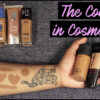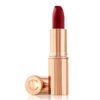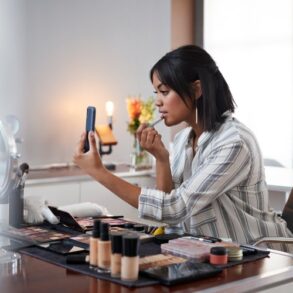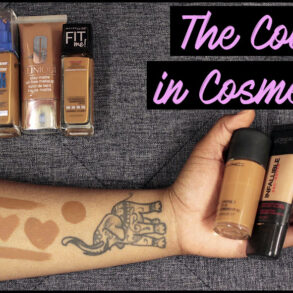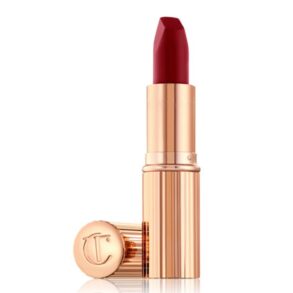Coming up with new outfits or playing with new cosmetic looks can be overwhelming. Whether there’s a new dress, hair, or makeup color you’ve been meaning to play with, it’s normal to feel iffy about breaking up with your everyday attire. Are you currently shying away from a bolder color palette? Here are 4 tried-and-true tips & tricks that will surely inspire you to hurdle out of your comfort zone.
1. What is the Difference Between Skin Tone vs. Undertone?
- Identifying Your Skin Tone: The term “skin tone” refers to the surface color of your skin (ranging from fair, medium, and dark tones), while
“undertones” are the color hues exalted by your light, medium or dark skin tone.
- Identifying Your Undertones: Here’s an easy trick– check the color of your veins on the inside of your wrist. Do they appear green or blue, or can you identify a sort of “in-between” shade of either one?
The general rule says that blue veins indicate a cool undertone, while green veins indicate a warm undertone.
A common misconception is that people can strictly present either cool or warm undertones. However, any skin tone can present warm, cool, or even neutral undertones.
- Blue veins: If you have fair or light skin that easily burns pink under the sun, it is likely that you have a cool undertone.
- Green veins: If you have a warm-beige, olive, or dark skin tone, it is likely that your skin tans easily and rarely burn, you likely possess warm undertones.
- Blue-Green or Purple veins: If the color of your veins seemingly blends in with your natural skin tone, or you can identify their color as a combination of blues, greens or purples, you may have a neutral undertone (and you may sway more toward cool undertones, warm undertones, or both at the same time).
2. What Colors Favor Your Undertones Best?
- Cool Undertones: black, grays, true white, cobalt blue, navy blue, dark emerald, evergreen, mint green, violets, raspberry pink, blush pinks, and bright reds.
- Warm Undertones: ivory, off white, browns, olive greens, amber, gold, peaches, corals, violet red, orchid red, and warm or orangey reds.
- Neutral Undertones: whites, medium blues, jade green, peaches, dusty pinks, and bright true red.
3. “HELP! One shade of lipstick looks great on my friend but not on me!”
- Hair and eye color are important factors to determine the right makeup shades for you. Consider these color-pairing tips according to your undertones, hair and eye color to satisfyingly elevate your daily makeup looks.
A. Guide for cool undertones, with dark eyes: black, brown, reddish, and hazel eyes.
| eyeshadow | blush | lipstick | |
| blonde hair | taupe, cool brown, icy silver, true pinks, purples, and blues |
strawberry pink shades | brown liner, with a center matching your blush |
| auburn / light brown hair | baby blue and pasty purples | doll pinks | pinkish nude gloss |
| dark brown / black hair | true reds, burgundy, purples, light silver | bright berry or mauve shades | pinkish nude or deep berry gloss |
| red hair | taupe, cool brown, and lavender | doll pinks | berry or true red lip |
B. Guide for warm undertones, with dark eyes: black, brown, reddish, and hazel eyes.
| eyeshadow | blush | lipstick | |
| blonde hair | baby blue or pastel pinks | pastel or strawberry pink shades | brown liner with mauve or pink nude lip with a center matching your blush |
| auburn / light brown hair | cobalt blue and rich browns | orangey peach, coral shades | rich nude brown or red-violet lip |
| dark brown / black hair | olive green, warm reds, true pinks, and orangey tans | orangey peach shades | orangey nude lip |
| red hair | jade green, burnt oranges and warm reds | tan bronze shades | deep purple berry or nude gloss |
C. Guide for cool undertones, with light eyes: green, blue, light caramel brown, and gray eyes.
| eyeshadow | blush | lipstick | |
| blonde hair | icy silver, plums, dark greens, mauve, and browns | light burnt peach shades |
true red lip |
| auburn / light brown hair | mint green, burgundy, and browns |
dusty or strawberry pink shades |
strawberry pink gloss |
| dark brown / black hair | taupe, deep browns, true pinks, purples, and blues |
doll pink or bright berry shades |
rich berry lip or nude gloss |
| red hair | taupe, mauve, burgundy, cool brown, and lavender |
doll pink, bright berry or mauve shades | berry or true red lip |
D. Guide for warm undertones, with light eyes: green, blue, light caramel brown, and gray eyes.
| eyeshadow | blush | lipstick | |
| blonde hair | brick reds with neutral brown smokey eye |
pink peachy shade |
neutral pink lip |
| auburn / light brown hair | medium blue, rich tans | true peach shade | rich brown lip, orangey pink gloss |
| dark brown / black hair | black, warm orange, blue smokey eye | strawberry pink shades | strawberry pink or warm red lip |
| red hair | deep browns, bronze, and gold | doll pink or peachy shades | nude or warm red lip |
4. Jewelry: Do Your Undertones Favor Gold or Silver?
Rule of thumb: gold jewelry appeals to warm undertones, while silver jewelry stands out on cooler undertones.
- Metals for warm undertones: bronze, yellow gold, gold, rose gold, and copper.
- Metals for cool undertones: white, silver, white gold, diamond, and pearls.
Can I mix gold and silver jewelry? ABSOLUTELY! Mixing these metals can help add depth and dimension to your outfit. Here is a practical playbook on mix-and-matching gold and silver jewelry:
- First, choose a pair of earrings that appeal to the undertones of your skin.
- Then, layer some rings, necklaces and bracelets. Sticking to the same hue of metal (for each silver and gold garment you select) works best.
- Preferably, the “chunkier” or flashier pieces out of your selection should mainly appeal to the undertones of your skin.
- Incorporate more muted pieces of the opposite metal, such as dainty rings, chains or pierces with small charms on them.
TIP: These gold and silver combinations look best with neutral clothing, such as ivory, whites, blacks, beiges, blues, and green-colored garments.
BE WARY: some gold hues can look opaque with cooler undertones, and the same goes for silver jewelry, which can look opaque with warm undertones. But have no fear! Here are some gold-and-silver combos to try out next:
Mix & match combos for:
- Cool undertones: choose white silver or pearl earrings. All goes for necklaces, bracelets, and rings: for every 2-3 silver pieces you pick out, pair them with 1 dainty gold garment (extra cool points if either the silver or gold pieces are crowned with deep green or blue gemstones). Play with black, gray, white, bright red, navy blue, or mint green clothing.
- Warm undertones: gold or yellow gold earrings will suit you best. Wear the same gold-colored jewelry pieces all throughout. Then, add a couple of dainty silver necklaces with a chunky element, like a charm or medallion. To unify both the silver and gold elements, consider adding pearl or diamond jewelry. Finally, add a chunky silver watch and pair your garments with brown, warm red, coral pink, amber yellow, or olive green clothing.
- Neutral undertones: you can delve a little bit into both worlds! Though, it would be cool to see you play with some silver, diamond, and gold or rose gold garments. Subtle and dainty jewelry works best for this combo. Pair your jewelry with white, medium blue, jade green or coral pink clothing!


